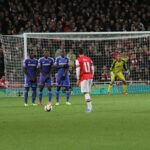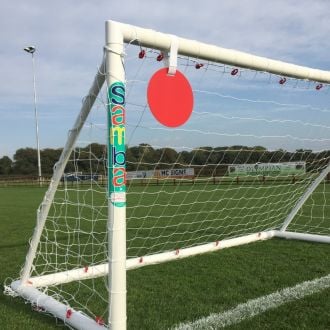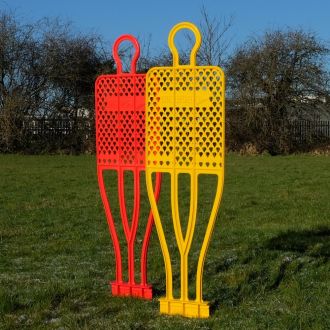How to Improve Your Shooting, Free-Kicks and Penalties
Scoring goals is what makes the beautiful game… well… beautiful. While there’s a certain beauty to a perfectly timed sliding tackle or a brave headed clearance, nothing beats the spectacle of a sweetly hit ball crashing into the back of the net.
Whatever your position, learning how to shoot effectively in all situations is crucial if you want to be successful in the game. Whether you’re in open play, taking a free-kick or stepping up to the penalty spot, technique, composure and confidence are essential.
To help you fine-tune your shooting skills, we’ve put together a few tips. With the right football equipment, you should be able to improve this essential skill in no time.
Tips for Taking Free-Kicks
Before you start practising your free-kicks, you’ll need a free-kick mannequin and a football goal. To ensure you can practise anywhere, however, opt for a lightweight, portable goal that can be erected and dismantled quickly.
As with everything related to football training, repetition is vital. Practise your free-kicks from a varied range of distances and angles. Here are a few tips to improve this key skill over time:
Practise with a goalkeeper
To recreate match conditions, practise with a goalkeeper wherever possible. This will give you an idea of how effective your technique is, and it’s a great way of developing accuracy.
Use several balls
Your training will become slow and boring if you’re constantly running to retrieve a ball after taking your free-kicks. Invest in a set of training balls so you have more time for practising.
Develop a routine
Watch the footballing greats take their free-kicks. Beckham and Cristiano Ronaldo are perfect examples. They both have their own free-kick rituals. Over the years, they’ve created a “mental anchor” that keeps them calm and in control. For you, this might be how you place the ball, how you breathe or how you adjust your shirt.
Tips for Improving Your Shooting
Shooting is arguably the most exciting aspect of football — but it’s also the most challenging. Alan Shearer, Sergio Aguero and Harry Kane make it look easy, but it’s anything but. All superstar strikers practise their shooting for hours and hours on the training pitch. Again, repetition is key.
Develop power
Power can hide deficiencies in accuracy and timing. How many times have you seen a shot beat a keeper through sheer power and speed. Even if the keeper gets a hand to one of these shots, the power alone is enough to guide the ball to the back of the net.
But power doesn’t come from lower body strength — at least not primarily. Power comes from technique. And this is where your training should begin. Repeatedly strike balls at a target, which can be a rebounder, a goal, a wall or anything that serves a similar purpose.
Once you’ve honed your technique and learned to connect with the ball sweetly on a consistent basis, power will come. Just keep developing your fitness and strength, and your shooting should improve over time.
Develop accuracy
Once again, repetition is crucial. Shooting accuracy is something that must be developed over time. Firstly, decide where you’re going to make contact with the ball. Curved shots require you to shift your body weight to one side and “stroke” the ball with the inside or outside of your foot.
A straight shot with power requires you to get both your head and foot over the ball. Lean back too much, and you risk sending your shot into the stands!
Get yourself a set of balls and a portable football goal. Set out a playing area and boundaries with training cones, and practise your shooting from a range of distances and angles. To improve your decision-making and ability to perform under pressure, practise with a goalkeeper and at least one defender as much as you can.
Tips for Improving Your Penalties
On the face of it, taking a penalty should be easy for a professional striker. So why do so many of them miss? It’s because psychology, pressure and high stakes are just as important as technique. And the only way to improve your penalty conversion rate in real matches is to recreate match conditions as much as possible.
If you’re practising your shooting skills regularly, your technique should already be reasonably good. But practising penalties is about facing as many different scenarios as you can.
When you’re training with friends, get them to surround you as you prepare to take your spot-kicks. And encourage them to throw a bit of banter your way. And if they’re up for it, get the keeper to cause a little mischief. Get used to taking accurate, powerful penalties when you’re surrounded by distractions, and your conversion rates will improve.
Build a routine
A penalty kick routine focuses your mind and settles your nerves. Decide on a routine that works for you, and stick with it. Some routines involve a certain number of steps before striking the ball. Others involve breathing or placing the ball on the spot in a certain way.
Learn how to fool keepers
For professionals, penalty kicks start in the classroom. All the great penalty specialists research how a keeper deals with penalties several days before a big match. This can give you an idea of which direction the keeper might dive to save your penalty.
You can hide the direction of your penalty kick in a number of ways, including where you’re looking, your run-up angle and the shape of your foot as you connect with the ball.
Visualise a goal
Alan Shearer said that he used to decide on a side before he started his penalty run-up, and nothing would change his mind. He’d picture a successful spot-kick in his mind’s eye, which would settle his nerves and boost his confidence. Practising the art of shooting is the only way you’re going to improve your stats on the pitch. Repetition is key, along with feedback, advice and continual improvement. But if you’re committed — and you have the right football training equipment at your disposal — your conversion stats should improve over time.





